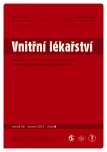The viewpoint of an internal medicine at the issue of an aortoenteric fistula
Authors:
I. Šturdík 1; T. Koller 1; V. Šišovský 2; Ľudovít Danihel 2; J. Payer 1
Authors‘ workplace:
V. interná klinika Lekárskej fakulty UK a UN Bratislava, Slovenská republika, prednosta prof. MUDr. Juraj Payer, CSc.
1; Ústav patologickej anatómie Lekárskej fakulty UK a UN Bratislava, Slovenská republika, prednosta prof. MUDr. Ľudovít Danihel, PhD.
2
Published in:
Vnitř Lék 2012; 58(6): 490-493
Category:
Case Reports
Overview
Aortoenteric fistula is an uncommon life-threatening disease; it can be divided into primary and secondary one. Primary aortoenteric fistula is the result of ongoing disease in the aorta and the intestine, secondary one is iatrogenic. Typical symptoms are abdominal pain and gastrointestinal bleeding (two-stage process). The most appropriate diagnostic method is CT aortography, treatment is only surgical. 75-year-old patient was admitted to the 5th Department of Internal Medicine in Bratislava due to progression of renal parameters, the patient had undergone an aortofemoral bypass 4 years ago. During the fourth day of his hospitalization the patient had a massive hematochezia with a shock state. After transient stabilization of the patient, 30 minutes after the first hematochezia, a massive hematemesis appeared and then the patient died. An autopsy has confirmed the secondary aortic-enteral fistula between the duodenum and the aneurysm arising from the aortofemoral bypass.
Key words:
aortoenteric fistula – hematemesis – melena – aortic aneurysm
Sources
1. Jovanovic I, Mojsic I, Milosavljevic T. Aortoenteric fistula: an uncommon cause of hematemesis with characteristic clinical presentation. Clin Gastroenterol Hepatol 2009; 7: A22.
2. Brown PW, Sailors DM, Headrick JR et al. Primary aorto-jejunal fistula: a case report. Am Surg 1999; 65: 139–141.
3. Sharma K, Kibria R, Ali S et al. Primary aortoenteric fistula caused by an infected abdominal aortic aneurysm with Mycobacterium avium complex in an HIV patient. Acta Gastroenterol Belg 2010; 73: 280–282.
4. Ozcakir N, Sherman SC, Kern K. Aortoenteric fistula. J Emerg Med 2011; 40: 61–62.
5. Bastounis E, Papalambros E, Mermingas V et al. Secondary aortoduodenal fistulae. J Cardiovasc Surg 1997; 38: 457–464.
6. O’Mara CS, Williams GM, Ernst CB. Secondary aortoenteric fistula: a 20 years experience. Am J Surg 1981; 142: 203–209.
7. Dachs RJ, Berman J. Aortoenteric fistula. Am Fam Physician 1992; 45: 2610–2616.
8. Koshy AK, Simon EG, Keshava SN. Education and Imaging. Gastrointestinal: aortoenteric fistula. J Gastroenterol Hepatol 2010; 25: 1014.
9. Jurgoš Ľ, Kužela L, Hrušovský Š a kol. Gastroenterológia. Bratislava: Veda 2006: 211–222.
10. Martínez Aquillar E, Acín F, March JR et al. Repair of secondary aortoenteric fistulas. A systematic review. Cir Esp 2007; 82: 321–327.
Labels
Diabetology Endocrinology Internal medicineArticle was published in
Internal Medicine

2012 Issue 6
Most read in this issue
- Teleangiectasia hereditaria haemorrhagica –Osler-Weber-Rendu syndrome. Case study and treatment experience
- Disturbances of hemostasis in sepsis
- Cladribine is highly effective in the treatment of Langerhans cell histiocytosis and rare histiocytic disorders of the juvenile xanthogranuloma group
- An effect of continuous and intermittent renal replacement therapy on antibiotic treatment in critically ill patients with sepsis – a practice-based perspective of vancomycin and gentamycin therapies
